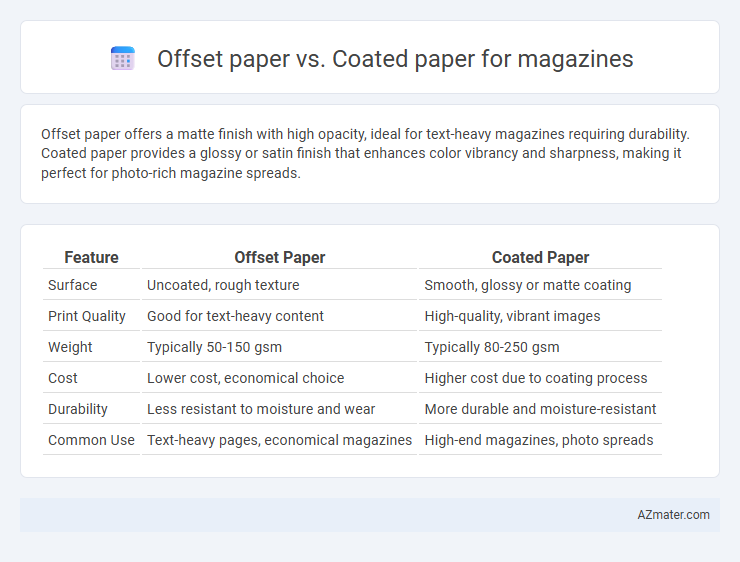Offset paper offers a matte finish with high opacity, ideal for text-heavy magazines requiring durability. Coated paper provides a glossy or satin finish that enhances color vibrancy and sharpness, making it perfect for photo-rich magazine spreads.
Table of Comparison
| Feature | Offset Paper | Coated Paper |
|---|---|---|
| Surface | Uncoated, rough texture | Smooth, glossy or matte coating |
| Print Quality | Good for text-heavy content | High-quality, vibrant images |
| Weight | Typically 50-150 gsm | Typically 80-250 gsm |
| Cost | Lower cost, economical choice | Higher cost due to coating process |
| Durability | Less resistant to moisture and wear | More durable and moisture-resistant |
| Common Use | Text-heavy pages, economical magazines | High-end magazines, photo spreads |
Understanding Offset Paper: Composition and Uses
Offset paper, primarily composed of wood pulp and calcium carbonate, offers high opacity and smooth surface ideal for excellent print quality in magazines. Its uncoated finish provides a natural matte appearance, ensuring comfortable readability and vibrant color accuracy for text-heavy or photography-rich pages. Widely used in magazine printing, offset paper excels in cost-effectiveness and compatibility with various printing technologies, making it a preferred choice for large-scale publishing.
What is Coated Paper? Types and Characteristics
Coated paper, commonly used in magazine printing, features a surface layer of coating materials like clay or latex that enhances gloss, brightness, and smoothness, providing sharper image reproduction compared to offset paper. The main types include gloss-coated, matte-coated, and silk-coated, each offering different finishes that impact the visual appeal and tactile sensation of printed pages. Characteristics of coated paper include improved ink holdout, vibrant color presentation, reduced ink absorption, and increased durability, making it ideal for high-quality magazine layouts with detailed graphics and photographs.
Key Differences Between Offset and Coated Paper
Offset paper features an uncoated, porous surface ideal for high-quality printing with sharp text but a duller appearance, while coated paper has a smooth, glossy or matte finish that enhances color vibrancy and image sharpness. Offset paper absorbs more ink, leading to slower drying times and a natural, textured feel, contrasting with coated paper's ink sits on the surface, resulting in faster drying and smudge resistance. Magazines printed on coated paper often display richer visuals and higher contrast, whereas offset paper offers superior readability and a tactile quality valued in editorial content.
Print Quality Comparison: Offset vs Coated Paper
Offset paper offers a matte finish with high bulk and excellent ink absorption, resulting in crisp text and sharp images ideal for editorial content in magazines. Coated paper features a smooth, glossy or satin surface that enhances color vibrancy and detail sharpness, producing richer visuals and more saturated images for photo-heavy publications. Print quality on coated paper excels in brightness and contrast, while offset paper provides superior readability and reduces glare in diverse lighting conditions.
Image and Color Reproduction: Which Paper Delivers Better Results?
Coated paper provides superior image and color reproduction for magazines due to its smooth, sealed surface that prevents ink absorption and allows for sharper, more vibrant visuals. Offset paper, typically uncoated, absorbs ink more readily, resulting in softer colors and less precise detail, which may diminish overall image quality. Therefore, coated paper is preferred for high-quality, visually impactful magazine prints where accurate color fidelity is essential.
Cost Analysis: Offset Paper vs Coated Paper for Magazines
Offset paper typically offers a lower cost per page compared to coated paper due to its uncoated surface and simpler production process, making it ideal for large print runs with budget constraints. Coated paper, while more expensive, enhances image sharpness and color vibrancy, adding value to high-end magazines that demand superior print quality. Considering printing costs alongside the desired magazine aesthetics is crucial for publishers balancing budget efficiency and visual impact.
Durability and Lifespan: Choosing the Right Paper
Offset paper offers high durability and a longer lifespan due to its uncoated surface, making it resistant to wear and tear, ideal for magazines with heavy handling. Coated paper, often featuring a glossy or matte finish, enhances visual appeal but tends to be more susceptible to surface damage and may degrade faster under frequent use. Selecting the right paper depends on balancing longevity with print quality, where offset paper ensures lasting durability while coated paper prioritizes vibrant imagery.
Environmental Impact: Sustainability of Offset and Coated Papers
Offset paper typically has a lower environmental impact due to its uncoated, often recycled content that requires less chemical processing and energy consumption during production. Coated paper, especially with glossy finishes, involves additional coatings and treatments that increase chemical use and reduce recyclability, posing challenges for sustainability efforts. Choosing offset paper for magazines supports eco-friendly practices by promoting biodegradability and easier recycling, aligning with growing demand for sustainable publishing.
Best Applications: When to Use Offset or Coated Paper in Magazines
Offset paper, known for its natural texture and high opacity, is ideal for magazines with extensive text, such as literary journals or academic publications, where readability and minimal glare are essential. Coated paper, featuring smooth surfaces and enhanced color vibrancy, suits magazines focused on high-quality images and advertisements, such as fashion, lifestyle, or photography magazines. Choosing between offset and coated paper depends on the magazine's emphasis on text clarity versus visual impact, balancing cost, print quality, and reader experience.
Making the Right Choice: Factors to Consider for Magazine Printing
Offset paper offers a natural, uncoated finish that enhances readability and is ideal for text-heavy magazines requiring cost-effective bulk printing. Coated paper provides a glossy or matte surface that intensifies color vibrancy and sharpness, making it suitable for magazines rich in images and high-quality graphics. Key factors to consider when choosing between offset and coated paper include the magazine's content type, budget constraints, desired aesthetic appeal, and printing method compatibility.

Infographic: Offset paper vs Coated paper for Magazine
 azmater.com
azmater.com